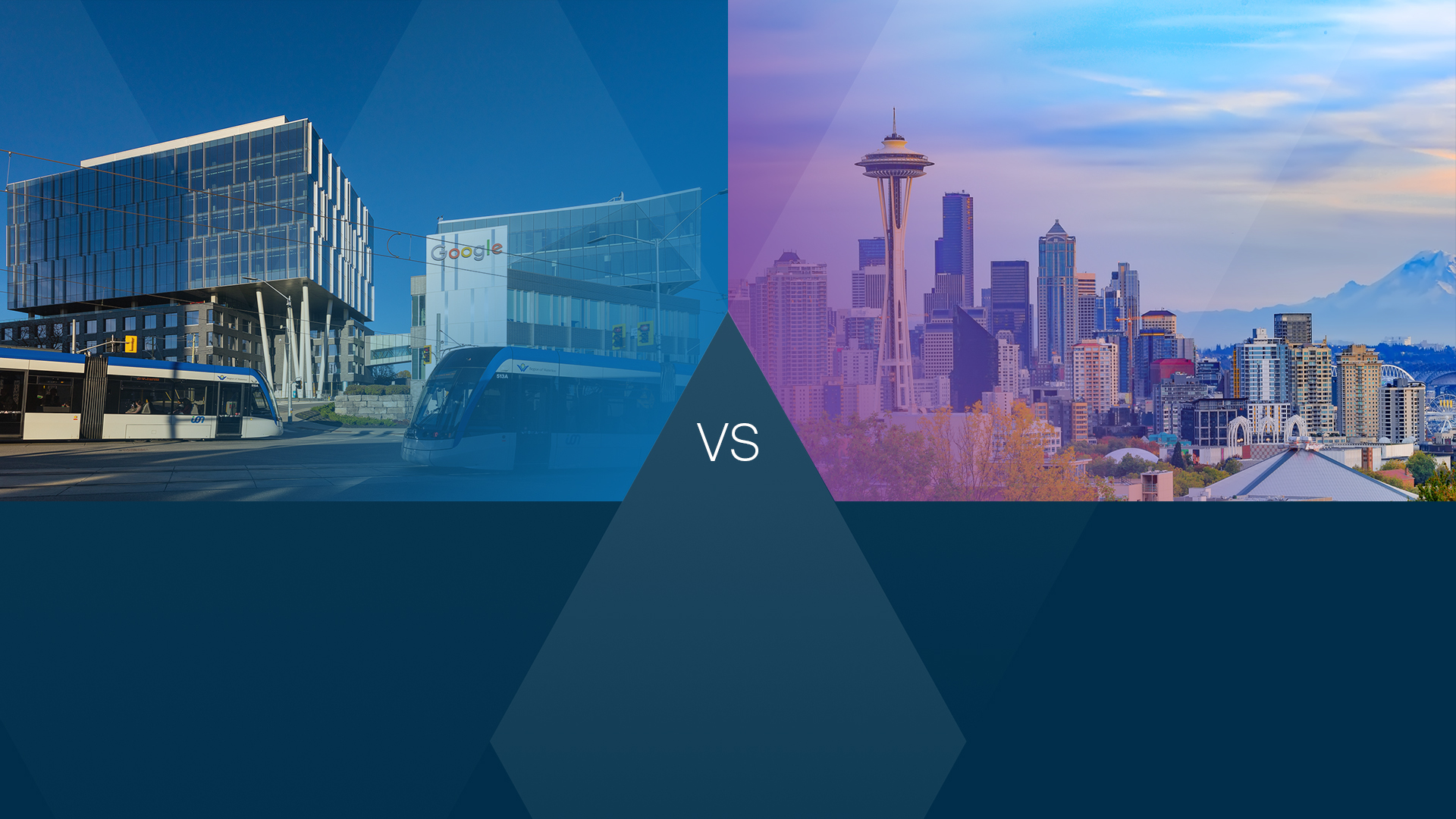Choosing the right location for expansion requires more than just a gut feeling. It takes data.
To help tech leaders evaluate their options, we’ve broken things down into four key areas: talent, demographics, cost and quality of life.
Talent is crucial to building a strong workforce and pipeline. Demographics shape both your hiring pool and your customer base. Costs affect your bottom line, and quality of life influences employee retention and satisfaction.
Our Tech Data Book simplifies this process. It consolidates insights from multiple sources to help you compare Waterloo and ten other top North American tech hubs – highlighting each region’s strengths and weaknesses with side-by-side data.
Seattle is home to tech giants like Amazon and Microsoft, a highly educated workforce and easy access to outdoor living – all hallmarks of a thriving tech hub. Similarly, the Waterloo area offers global brands, world-renowned research institutions and a fast-growing tech community. These two regions make for a compelling comparison across all four categories.
Let’s dive in.
Data Point #1: Tech workforce size and growth
| Total Tech Workforce | Concentration | Growth (5 years) | |
|---|---|---|---|
| Waterloo | 29,100 | 9.6% | 45.5% |
| Seattle | 195,390 | 9.4% | 20.4% |
Source: CBRE Scoring Tech Talent Report 2024
Data on tech workforce size and growth is essential to understanding a city’s talent pool and talent pipeline. As talent is often the top priority for tech companies, these statistics are crucial to ensuring your new location can support your growth.
While Seattle’s total tech workforce is larger, Waterloo’s tech talent concentration and growth is much stronger. In fact, our five-year growth more than doubles Seattle’s. This data puts us in the #1 spot on CBRE’s list of small tech talent markets in North America.
Seattle is home to global tech giants like Amazon and Microsoft, while Waterloo hosts major players such as Google, SAP, Bosch and EPAM Systems. What sets Waterloo apart is our ecosystem – one that gives talent hands-on experience at the intersection of tech, quantum and robotics, creating a workforce with future-ready skills.
Data Point #2: Population growth
| Overall Growth Population | Growth in the Age 20-30 Demographic | Growth in Age 30-40 Demographic | |
|---|---|---|---|
| Waterloo | 3.7% | 29.2% | 20.2% |
| Seattle | 3.7% | 0.3% | 13.5% |
Source: Lightcast, 2023. Population growth from 2017-2022 at the CD/MSA level; CBRE Scoring Tech Talent Report 2024
While overall population growth is equal, Waterloo Region is seeing far greater growth among young professionals – particularly in the 20-40 age range. In fact, Waterloo has the fastest-growing millennial and new-grad populations in North America, according to CBRE’s 2024 report.
This kind of growth points to a stronger talent pipeline, a growing customer base and increased opportunities for collaboration – all of which contribute to a vibrant tech ecosystem.
Much of this momentum comes from our post-secondary institutions. With over 109,000 students enrolled at the University of Waterloo, Wilfrid Laurier University and Conestoga College, Waterloo is home to a steady stream of professional talent with diverse skill sets.
A key driver of our tech success, the University of Waterloo is the largest of the world’s top-ranked tech universities – and a globally-renowned computer science school.
Data Point #3: Estimated one-year company costs
| Estimated cost (USD) | |
|---|---|
| Waterloo | $37,561,739 |
| Seattle | $67,381,189 |
Source: CBRE Scoring Tech Talent Report 2024 – based on office space and wages for 500 people
With a hefty price tag of $67M, Seattle is $30M more in company costs per year than Waterloo. Company costs are based on 60,000 sq. ft. of office space and annual wages for 500 employees – the benchmark used by CBRE.
A great work environment is key to strong collaboration between employees and great work culture. In Waterloo, you can get incredible office space for a fraction of the price you would pay in Seattle.
Data Point #4: Payroll Taxes
| Payroll Tax per Software Engineer (USD) | |
|---|---|
| Waterloo | $4,258.72/year (based on a salary of $82,515) |
| Seattle | $11,661.91/year (based on a salary of $142,940) |
Source: Salaries from Economic Research Institute, Q3 2024. Taxes from respective governments.
It may come as a surprise, but Canada’s business taxes are exceptionally competitive with the United States. As a tech company growing in Waterloo, you’ll experience significantly lower payroll taxes than in Seattle. This is due to lower salaries and a beneficial exchange rate, but also, we just have lower mandatory expenses for unemployment insurance, social security and more.
Washington State may offer tax advantages compared to other US regions, but Waterloo remains the more cost-effective option overall.
Companies in the Waterloo region can also access several business and innovation incentives. With a wealth of municipal, provincial and federal incentives at your disposal, you can save on R&D, labour and expansion costs in Waterloo.
Data Point #5: Diverse talent
| Immigrant as a % of the total population | |
|---|---|
| Waterloo | 25.8% |
| Seattle | 20% |
Source: Statista, January 2023
With 26% of its population born outside of Canada, Waterloo is one of North America’s most diverse tech hubs. This global talent pool brings cross-cultural expertise, unique perspectives and the kind of innovation businesses need to stay competitive.
The Waterloo area is also home to over 120 languages and a vibrant, inclusive community. As our population grows, so does the influx of international talent – enriching our ecosystem and driving tech innovation from different angles.
Our Tech Data Book includes thirteen tables comparing everything from salaries and payroll taxes to population growth and talent diversity across eleven North American tech hubs – including Pittsburgh, Silicon Valley, Detroit and Austin. Download your free copy today.
